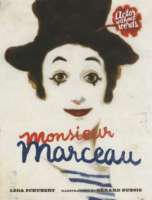
Marcel Marceau, the world’s most famous mime, enthralled audiences around the world for more than fifty years. When he waved his hand or lifted his eyebrow he was able to speak volumes without ever saying a word. But few know the story of the man behind those gestures…
Distinguished author Leda Schubert and award-winning artist Gerard DuBois bring their own artistry to this picturebook biography.
- ISBN: 9781596435292
- Author: Schubert, Leda
- Illustrator: Dubois, Gerard
- Published: 2012 , Roaring Brook Press
- Themes: Performing Arts
- Descriptors: Biography - Autobiography- Memoir, Europe, France, Picture Book, Primary (ages 6-9)
- No. of pages: 32

Kathleen: There is something magical about Marcel Marceau that makes you want to smile, and participate in his act. I think what I had always liked most about Marcel Marceau is that his mime could be understood in any language. He told his story through movement and facial expressions.
Tracy: I agree Kathleen. I remember this man from my childhood— seeing him on TV as a little girl, my mother explaining to me the craft of “mime.” I think I was most amazed by the fact he could NOT, under any circumstance, talk— that was a violation of the art. And come to think of it, I don’t think I ever did hear him talk, though the book explained that out of character he was quite the chatter-box.
Kathleen: From this informational picture book story, young readers will enjoy learning about the life of this famous Mime. The text seems to start with rhyming verse, but changes to story – format, while engaging the reader into the life of Marcel Marceau. For example did you know he joined the French underground to resist the Nazis and led hundreds of Jewish children form an orphanage to safety in Switzerland? These events could possibly be the reason why his career as a mime came about. He is quoted in the book saying, “My name is Mangel. I am Jewish. Perhaps that, unconsciously, contributed towards my choice of silence.”
Tracy: Funny you pulled that quote! It was one that stuck with me. The metaphor of silence in light of the horrific crimes against the Jewish people during WW II is powerful. And I had no idea about his participation in the war— he was a bonified hero! I only knew him as a mime.
Kathleen: Well into the book the reader is drawn into the illustration of Monsieur Marceau’s mime face with the big red flower. Through his illustrations Gérard DuBois captures the exact feeling of what it must be like to watch this world famous mime as he entertains audiences without a singular word. The illustrations when talking about mime are playful, vivid, and lively. But at the beginning when the story of his young life is introduced, the illustrations are dark and grey, portraying the mood of World War II, and life as a Jewish person.
Tracy: I agree. The artwork is brilliant!
Kathleen: In the afterword you learn more about his life, but also are invited to try mime by reading through directions of “pretending.” I can imagine reading this to a group of young learners and asking them to pretend to eat a banana, or pour milk into an imaginary glass and drink it. What a great book to bring in movement in order to transact with this text.
Tracy: I love the idea of kids trying out the mime— wouldn’t that be a blast!? You know, mimes get a bad rap, are often made fun of, seen as creepy… Just the other day on a re-run of Anthony Bourdian he was in France and upset because while sitting in a park a mime came to perform for him— was very snarky about the whole scene. Perhaps reading this book, and learning about such a remarkable man and beautiful art form, kids will come to appreciate both Monsieur Marceau and the performance art of mime. This is an excellent biography parents and teachers will want to share with children.